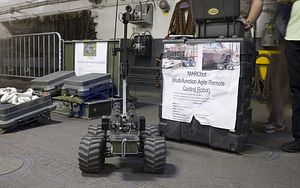Unlike most adventure cartoons, the human characters in the Japanese cartoon Pokemon usually avoid dangers, instead relying on their “pocket monsters” to do the fighting. This unique style of combat may in fact anticipate the battlefields of the future, once military robots are in widespread use.
Although long-range weapon systems, especially remote-controlled drones, have considerably lower the exposure of military personnel in recent years, while reshaping relations between people and machines in modern warfare, the advantage has so far been limited to certain aviation units – in most theaters, “boots on the ground” are still indispensible. However, trends in robotic warfare may gradually transform combat, including infantry, into remote controlled, or even remote monitored, encounters, given the application of certain automatic functions. In other words, soldiers and their robots will be in different places, allowing the former to operate at lower risk. Without lethal threats, soldiers will be able to calmly operate robots free of physical constraints such as fatigue or heat, achieving superior performance.
This “Pokemon warfare” would indeed reduce casualties, and would help with other human resources issues as well. If the principal job of a soldier is to remotely operate or monitor a robot, the physical and psychological requirements would be less onerous than the present standards, giving militaries access to a wider pool of potential applicants. As has been seen with the drone experience, rookies without field experience may be more desirable than experienced veterans. As a result, a lot of ground training may be waived or at least scaled back, reducing costs. Moreover, controlling or monitoring robots would ease the popular worry about an extreme scenario in which autonomous robots lower the threshold of the use of violence, a concern again raised at the recent International Joint Conference on Artificial Intelligence in Buenos Aires.
Yet, even this middle way would nevertheless significantly change the nature of warfare, in several respects.
Operators or Soldiers
The biggest impact of Pokemon warfare would be on ground troops. The United States and Russia have developed a range of field robots to replace field soldiers and manned platforms. As more and more soldiers operate those robots remotely instead of fighting on the actual battlefield, a dramatic military paradigm shift will take place. Officers and other defense planners may baulk at such a major change given their concerns about an over reliance on robotics, but for political leaders, recruitment difficulties, training costs, and limited public tolerance for casualties could very well outweigh military concerns and encourage military doctrines oriented toward robot operation, with attendant organizational reforms. Of course, a major shift like that does not happen immediately, and the paradigm could be altered as military planners focus on the way in which robots are used.
Could the availability of robots become the new standard for combat sustainability? Despite Clausewitz’s emphasis on the clash of wills in war, material conditions often affect the resolve of commanders and soldiers. In the era of cold weapons, fighting was able to last until the collapse of will or the loss of physical capacity. The advent of gunpowder made ammunition and firearms an additional standard for fighting, although bayonets, shovels, and other cold weapons still played a secondary role. If future warfare relies heavily on robots, their loss may be tantamount to the end of effective fighting. When soldiers are accustomed to being kept away from direct engagement, they might be reluctant to fight themselves. And soldiers with lower physical and psychological standards may not be fit for combat, or their commanders may not be confident deploying human soldiers instead of robots. In the future, soldiers without robots could be as hopeless as the human figures without their pocket monsters in the Pokemon cartoon.
Human-Centered Objectives
From the perspective of an adversary, defeating a few robots alone would be unlikely to make enemies subordinate to their will; human-centered attacks would be more efficient. Asymmetrical adversaries would soon realize that conventional tactics like ambushes would be unlikely to achieve the desired political ends when used on robots. Accordingly, they are likely to turn to terrorist attacks, assassination, and other means directed at civilian and military personnel. If robots are encountered, pretending to be innocent may be more effective than fighting.
In a symmetrical scenario, the enemy would have more resources to choose from. In terms of neutralizing robots, the main purpose would be not to destroy them but to render their human operators helpless. Electronic countermeasures, cyber-attacks, and specific anti-robot weapon systems could be applied for that purpose. Such attacks would mainly be used for the effects on human beings, rather than on the tactical measure of destroying robots. As for direct attacks on people, long-range missiles and other munitions could be used to attack human operators well removed from the conventional battlefield. As long as human beings are still part of the decision-making process, robots are unlikely to shoulder all of the dangers of combat.
The trend toward military robotics seems unstoppable, given the political and military needs it serves. But robots will be no panacea, in either regular or irregular warfare. Both asymmetric and symmetric adversaries will eventually find countermeasures. Moreover, warfare is by nature a clash of wills, and unless robots are made fully automated and commanded by an artificial intelligence, they cannot completely eliminate the element of human resolve. Indeed, an over dependence on robotics could erode human will. If these factors are not adequately considered in military planning, an asymmetric military loss with advanced robots, similar to the U.S. ending the Vietnam War with vastly superior air and sea power, is not unimaginable.
Shang-su Wu is a research fellow in the Military Studies Programme, a constitute unit of the S. Rajaratnam School of International Studies (RSIS), Nanyang Technological University, Singapore.

































